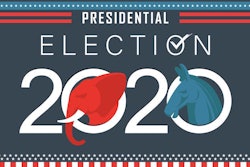Forecasting the economy — and the heavy-duty trucking industry in particular — is a tricky proposition as the pall of uncertainty caused by the coronavirus pandemic continues to linger. Despite the unknowns, the message during the Heavy Duty Manufacturers Association’s (HDMA) webinar held Wednesday had the tenor of guarded optimism.
Jim Meil, principal, industry analysis, ACT Research, describes the overall economy as “surprisingly good,” though he acknowledges context is everything.
“Compared to where we were in August of 2019, not so great. But compared with the very dark days of late March, April and May of this year, it’s actually pretty good,” Meil says. “We never would have thought we’d be in the midst of what might be the worst post-1945 recession.”
He says doubt, anxiety and potential risks remain high because the cause of the recession was biomedical, therefore “not amenable to an easy financial economics fix.” However, the recession has hit the services sector harder than the goods sector, so recovery favors the trucking industry, he says.
At the end of March the stock market tumbled and Dow Jones trucking stocks were down 20 percent. Since that low, the Dow Jones trucking stock index is up 32 percent year-to-date compared with the S&P 500 that’s up 5 percent, Meil points out.
“I don’t want to overpitch this, but what had been all darkness, now there’s light at the end of the tunnel. Things are getting better … and that sets the stage for a 2020 that is surprisingly promising in the context of where we’ve been,” he says adding that a recovery through the fourth quarter and into 2021 is certainly possible.
Steve Tam, vice president, analysis, ACT Research, notes a “nice snapback” of more than 20,000 orders that were placed for new trucks in July. Increasing freight and tight capacity “portends well for the future path of incoming orders,” he adds.
The medium-duty market tends to be somewhat insulated from what happens on the Class 8 part of the truck market because medium-duty trucks participate heavily in the services sector, Tam says. “This time around medium-duty also took a pretty good hit. It will be down 10 percentage points on a year-over-year basis if our forecast comes to fruition,” he says.
However, he adds, there is still is quite a bit of freight hauling that takes place in this medium-duty space, “maybe even more so today with changes in customer buying habits and distribution patterns because of an increase in online sales and an increase in home delivery, which is driving demand for these smaller vehicles.”
Regarding trailers, the backlog is turning more quickly than power units. What’s more, Tam says fleets have indicated they’re adding to their capital expenditure budgets for this year — after dramatically cutting them in the immediate aftermath of the COVID-19 outbreak — for trucks as well as trailers.
Despite many positive indicators for the general economy and the trucking industry, parts of the HDMA’s latest preliminary Pulse Survey results from its members paints a different picture.
“[Though] slight, there seems to be a move toward pessimism in the overall outlook. Since about late June the once positive outlook at how we would end the year has slowly eroded,” says Richard Anderson, HDMA director, market research and analysis.
When members were asked to rank the challenges to restarting normal business operations, the overwhelming response continues to be “Accuracy of production and demand forecasts” at 57 percent. A distant second at 14 percent was “Business cash flow,” followed by “Labor force readiness and availability” and “Closure mandates of own facilities” at 11 percent each. “Raw material and semi-finished goods procurement” rounded out the poll question at 7 percent.
“Forecast accuracy dropped below 50 percent for the first time five weeks ago but we’ve seen it come back. In fact, the unknown is the consistent theme of comments,” Anderson says.
Several survey respondents commented that the greatest challenge was the unknown surrounding a second wave of mass coronavirus cases, new government regulations and day-to-day forecast accuracy. “That really does sum up the supplier situation at this time. There still are many elements of the unknown that create huge business challenges,” he says.










